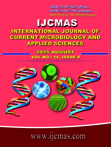


 National Academy of Agricultural Sciences (NAAS)
National Academy of Agricultural Sciences (NAAS)

|
PRINT ISSN : 2319-7692
Online ISSN : 2319-7706 Issues : 12 per year Publisher : Excellent Publishers Email : editorijcmas@gmail.com / submit@ijcmas.com Editor-in-chief: Dr.M.Prakash Index Copernicus ICV 2018: 95.39 NAAS RATING 2020: 5.38 |
The discharge of toxic effluents from various textile industries adversely affects the water resources, soil fertility, aquatic organisms, and ecosystem integrity. Toxic effluents containing azo dyes are discharged from various industries, and they adversely affect water resources, soil fertility, aquatic organisms, and ecosystem integrity. They pose toxicity (lethal effect, genotoxicity, mutagenicity, and carcinogenicity) to plants, aquatic organisms, as well as animals. Considering the potential applications of bioremediation processes in wastewater treatment, the present investigation targets the complete detoxification of Acid Red-88 by acute toxicity in Danio rerio, genotoxicity in Allium cepa, cytotoxicity in CHO cell lines, and phytotoxicity studies on Macrotyloma uniflorum and Sorghum vulgare. The study further emphasizes the urgent need for sustainable treatment strategies to minimize the ecological footprint of industrial effluents. It also highlights the role of biological indicators in assessing environmental safety. Moreover, the findings are expected to contribute towards developing eco-friendly methods for azo dye degradation. Ultimately, this research aims to provide a scientific basis for integrating bioremediation into large-scale wastewater management systems.
Arulprakash, A., K. Sathishkumar, M. S. AlSalhi, S. Devanesan, P. Mani, S. Kamala Kanan, S. Vijayanand, A. Rajasekar (2022). Integrated approach of photo-assisted electrochemical oxidation and sequential biodegradation of textile effluent. Environmental Pollution. 307 (15), 119412. https://doi.org/10.1016/j.envpol.2022.119412.
Aswinkumar, S., N. Arunagirinathan, S. Vijayanand, J. Hemapriya and Indra, V. (2017). Bioremediation and Detoxification of a Textile Azo Dye-Evans Blue by Bacterial Strain AKIP2. Int. J. Curr. Microbiol. App. Sci. 6(5): 2687 - 2694. ttp://dx.doi.org/10.20546/ijcmas.2017.604.313.
Barathi, A., J. Hemapriya, Ramya Gunasekaran, Kayeen Vadakkan, A. Shyamala, Aswini Ravi and Vijayanand, S. (2020a). Bioremediation of Textile and Tannery Effluents – An Overview. Int. J. Curr. Microbiol. App. Sci. 9(11): 3782- 3790. https://doi.org/10.20546/ijcmas.2020.911.454.
Barathi, A., J. Hemapriya, Ramya Gunasekaran, Kayeenvadakkan, A. Shyamala, Aswini Ravi and Vijayanand, S. (2020b). Biodegradation and Detoxification of Congo Red by Intuitive Bacterial Strain TVU-CR4. Int. J. Curr. Microbiol. App. Sci. 9(11): 3772-3781. https://doi.org/10.20546/ijcmas.2020.911.453.
Bavani, T., J. Madhavan, S. Prasad, M. S. AlSalhi, M. A L Jaffreh and S. Vijayanand. (2021). Fabrication of novel AgVO3/BiOI nanocomposite photocatalyst with photoelectrochemical activity towards the degradation of Rhodamine B under visible light irradiation. Environmental Research 200 (2021) 111365. https://doi.org/10.1016/j.envres.2021.111365.
Das, H.S., Reshma Girirajan, Rajalakshmi Balaji, S. Vijayanand and Hemapriya, J. 2024. Sustainable Approach for the Bioremediation of Textile Azo Dye – Metanil Orange by Textile Effluent Adapted Bacterial Strain JHP-1. Int.J.Curr.Microbiol.App.Sci. 13(6): 278-285. https://doi.org/10.20546/ijcmas.2024.1306.030.
Hemapriya, J and S. Vijayanand. (2013). Bioremediation of Structurally different textile dyes by a novel bacterial consortium. Int.J.Curr.Microbiol. Appl.Sci., 2(11):212- 226.
Hemapriya, J., Rajesh Kannan and S. Vijayanand. (2010). Bacterial decolorization of textile azo dye Direct Red-28 under aerobic conditions. J. Pure Appl. Microbiol., 4(1):309-314.
Hemapriya, J., Rajesh Kannan and S.Vijayanand. (2010). Bacterial decolorization of textile azo dye Direct Red-28 under aerobic conditions. J.Pure Appl.Microbiol., 4(1):309-314.
Puvaneswari, N., J. Muthukrishnan and P. Gunasekaran. (2006). Toxicity assessment and microbial degradation of azo dyes. Ind. J. Exp. Biol., 44:618-626.
Saratale, G.D., S.D.Kalme and S.P.Govindwar. (2006). Decolorization of textile dyes by Aspergillus ochraceus (NCIM-1146). Ind. J. Biotechnol., 5:407- 410.
Saratale, R. G., G. D.Saratale, D. C. Kalyani, J. S. Changand S. P. Govindwar. (2009). Enhanced decolorization and biodegradation of textile azo dye Scarlet R by using developed microbial consortium GR. Bioresour. Technol., 100: 2493-2500.https://doi.org/10.1016/j.biortech.2008.12.013
Shyamala, A., J. Hemapriya, Kayeen Vadakkan and S.Vijayanand. (2014). Bioremediation of Methyl Orange, a Synthetic azo dye by a Halotolerant Bacterial strain. Int. J. Current Research and Academic Review. 2(8):373- 381.
Vijayanand, S. and J. Hemapriya. (2013). Bacterial bioremediation of textile azo dyes A Review. Ind. J. Appl. Res., 3(12): 480-482.
Vijayanand, S., Kayeen Vadakkan and Hemapriya, J. (2017). Ecofriendly Bioremediation of Acid Orange - An Electron Deficient Xenobiotic Chromogen by Haloalkaliphilic Bacterial Consortium TVU- AO 64. Int.J.Curr.Microbiol.App.Sci., 6(4): 956- 963. http://dx.doi.org/10.20546/ijcmas.2017.601.113.
Das, H.S., Reshma Girirajan, Rajalakshmi Balaji, S. Vijayanand and Hemapriya, J. 2024. Sustainable Approach for the Bioremediation of Textile Azo Dye – Metanil Orange by Textile Effluent Adapted Bacterial Strain JHP-1. Int.J.Curr.Microbiol.App.Sci. 13(6): 278-285. doi: https://doi.org/10.20546/ijcmas.2024.1306.030
 |
 |
 |
 |
 |